

© Shipping Wonders of the World 2012-

Signalling at Sea
The development of marine communications from the makeshifts of the sixteenth century to the fine art of to-
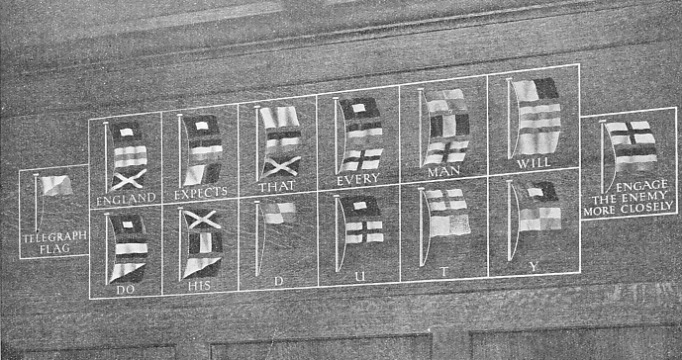
NELSON’S FAMOUS SIGNAL AT TRAFALGAR on October 21, 1805. Nelson sent his signal at the beginning of the battle in which he received his fatal wound. This photograph shows the signal on the wall of the Nelson Room at Lloyd’s. To-
“WHEN you wish to assemble the captains of your ships or to to speak with them, you will put on the mainmast a square banner tied in a weft.” Such is the instruction of the Gunner of the King of France in the first sea signalling manual, published in 1543. Captains are further directed to place banners in different parts of their ships, to shout, blow trumpets and beat drums, and to “ hang out a flaming cresset ” at night, to communicate with one another.
From these crude beginnings signalling at sea has become a fine art, culminating in the revision of the International Signal Code in 1934, the flags of which are given in the accompanying coloured plate. Almost every ship carries a complete set, which consists of twenty-
Besides being used as a decimal point when signalling figures, the answering flag has a variety of uses. The substitute flags are used to avoid the repetition of a letter in a signal. For instance, “A A A” in the code (meaning “1 point on the port bow”) would necessitate three “A” flags being carried; but, using substitutes, the first repeats the first flag in the group hoisted, the second repeats the second flag, and so on. Thus, “D H D L”, which is the code signal allotted to the Hamburg South American liner Cap Arcona, is signalled by using the flags “D H -
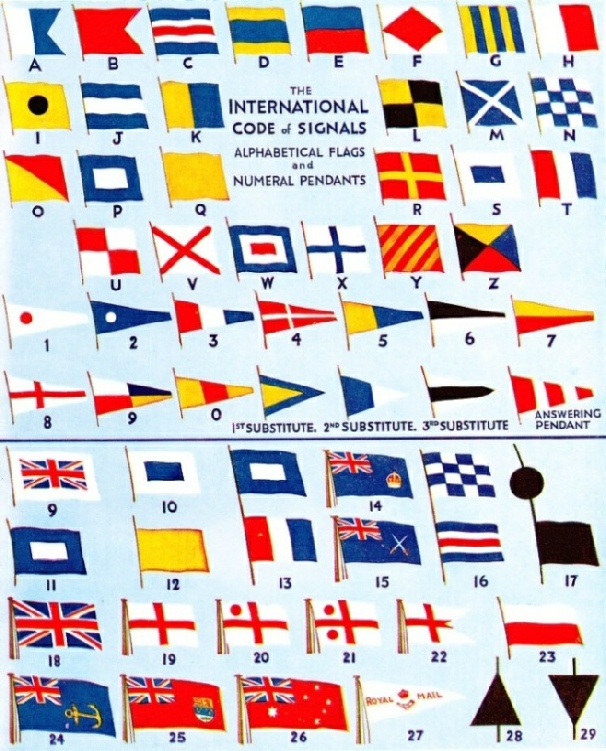
INTERNATIONAL CODE, SECOND MEANINGS
A-
G-
(At sea—your lights are out); Q-
9. British Pilot Signal. (Is also flown at the bow by ship which is flying pilot flag H, or No. 23.)
10. Engines going astern.
11. The Blue Peter -
12. Quarantine Flag.
13. International Code Pilot Signal (P.T.)
14. Customs House Flag.
15. War Department Flag.
16. Distress Signal. (Letters N.C. of International Code.)
17. Distress Distant Signal. (Seldom used.)
18. Admiral of the Fleet -
No. 1.)
19. Admiral.
20. Vice-
21. Rear-
22. Commodore’s Broad Pennant.
23. British Pilot Boat Flag.
24. Blue Ensign, flown by Fleet Auxiliaries.
25. Canadian Merchant Ensign.
26. Australian Merchant Ensign.
27. Royal Mail.
28. Cone warning of Northerly Gale.
29. Cone warning of Southerly Gale.
Where a signal contains three similar letters, it is given in this way: “S W S S”, standing for the Greek ship Zannis L. Cambanis, would be hoisted as “S W -
To acknowledge a signal the answering pendant is hoisted “close up” -
The code is divided into single-
Single-
A -
B -
C -
D -
E -
F -
G -
H -
I -
J -
K -
L -
M -
N -
O -
P -
P -
Q -
R -
S -
T -
U -
V -
W -
X -
Y -
Z -
“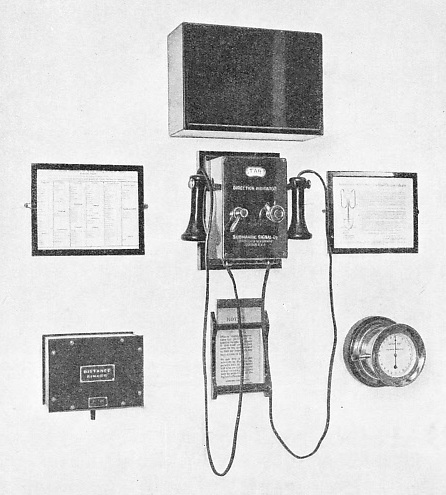 P” followed by four numerals indicates latitude and longitude, so that “P 1025-
P” followed by four numerals indicates latitude and longitude, so that “P 1025-
“T” followed by figures represents time, reckoned on the twenty-
“X” followed by numerals is used to signal bearings. “X 90” means “Bearing 90 true”, and can be used with other signals.
SUBMARINE SIGNAL DIRECTION INDICATOR. This comprises submarine signal receiving and distance-
Two-
Aircraft
B L -
B Y -
Buoy
G F -
G K -
Heave To
O L -
Name
S A -
Weather
Y Q -
Y R -
Three-
Geographical names are arranged as four-
A A A S -
A C D U -
A F C Z -
A G J V -
A G O V -
A J M F -
A M P M -
Four-

THE MORSE CODE is in general use throughout the world. This is a simple code, based on a combination of dots and dashes. The most frequently used letters are the shortest in Morse -
The distinguishing initial letters of the principal maritime nations are:-
G -
K -
D -
F -
J -
I -
L A -
P A -
Thus, Aquitania is “G L R Z”, Homeric “G D L J”, Bremen “D O A H”, and Atlantis “G L T M”.
Ships’ signal letters and wireless call-
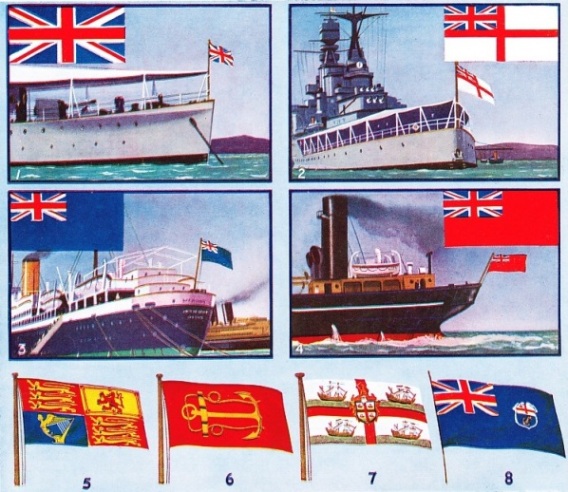
FLAGS AND THEIR MEANINGS
1. Union Flag, flown at the bow by all warships when at anchor.
2. White Ensign, flown by H.M. warships and yachts of the Royal Yacht Squadron (R.Y.S.).
3. Blue Ensign -
4. Red Ensign, flown by all other merchant ships.
5. Royal Standard.
6. Admiralty Flag.
7. Trinity House Flag.
8. Lloyd’s Ensign, flown at signal stations.
Should a ship wish to transmit a message which cannot be conveyed by the existing code, but must be spelt out, as with a name and address, the answering pendant is hoisted over the letter “E”, meaning that the letters shown after it are to be taken as spelling a word, and not as code signals.
Answering pendant over “F” indicates the end of a word, or a dot between initial letters; and the answering pendant over “G” means that the spelling is concluded, and that the subsequent flags represent code signals.
For example:
Message: “ Please inform owner -
The “hoists” would be:
H R B (from code) -
“Please inform owner”.
Answering pendant and E -
W I L -
I A M -
Answering pendant and F -
T H O M -
S O N -
Answering pendant and G -
B I R (from code) -
“Expect to arrive”
A J -
P K -
The answering pendant is then hoisted to indicate that the message is finished.
One-
There are several pilot signals. The code flags “G” or “P T” indicate a “I require a pilot”, as does the Pilot Jack (the Union Jack with a white border) when hoisted at the fore. By night a blue light shown every quarter of an hour, a white light frequently flashed just above the bulwarks, or “P T” in the Morse code is used for the same purpose.
In the Channel, where pilot cutters of several nationalities await incoming ships, blasts on the whistle or flashes with a lamp show the port for which a pilot is required. Five blasts or flashes, or a red over two white lights, means Antwerp; a long-
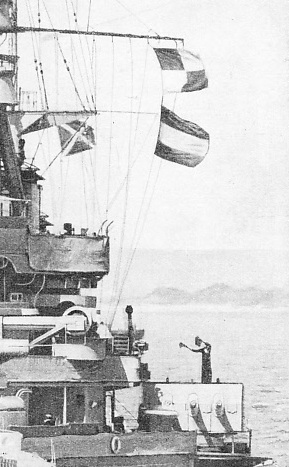 Ships entering port show the “Q” flag, meaning “My ship is healthy”. “Q Q” (“Q” and first substitute), “I am suspect -
Ships entering port show the “Q” flag, meaning “My ship is healthy”. “Q Q” (“Q” and first substitute), “I am suspect -
SIGNALLING IN H.M.S. REPULSE. Note the insulated leads of the wireless, the flag signals at the yards, the signalling searchlight for long-
Since January 1, 1933, British ships of over 150 tons register, engaged on oversea voyages, have been compelled to carry a signalling lamp. It is placed at the masthead or in some other conspicuous position, and the Morse code is used to transmit messages. A hand-
The one-
The mechanical semaphore and semaphore flags are both in extensive use at sea to-
In foggy districts submarine bell signalling is used and many lightships are fitted for the purpose. The sound travels through the water and is picked up by vessels equipped with a suitable receiver. Each lightship has its own “call”, sometimes its wireless call-
By receiving wireless signals and the submarine bell from a transmitting station, a ship’s distance can be accurately measured. This is done by comparing the difference in time taken to receive the two signals. Wireless waves travel faster than the submarine sounds, and the interval between the two indicates the distance away of the transmitter. Calculations are made also with wireless and ordinary sound fog-
Another, but rarer, method of signalling is by groups of “shapes’’ -
Storm signals are exhibited on the coast to warn seamen of approaching gales. A cone, hoisted point uppermost, or a triangle of lights, point uppermost, generally indicates a gale from the north, and the same signals reversed a gale from the south. This system is almost universal, but where easterly gales are to be expected the cone, when hoisted point uppermost, may mean a gale from that quarter. There are other local exceptions.
The United States have a different system. A red flag with a black centre is hoisted as a storm signal, with pendants to indicate the direction from which it is expected. A red pendant indicates from north-
All too frequently distress signals follow those indicating a storm. The code flags “N C” mean “I am in distress and in need of immediate assistance”. A square flag, with a ball, or anything resembling a ball, hoisted with it, has the same meaning.
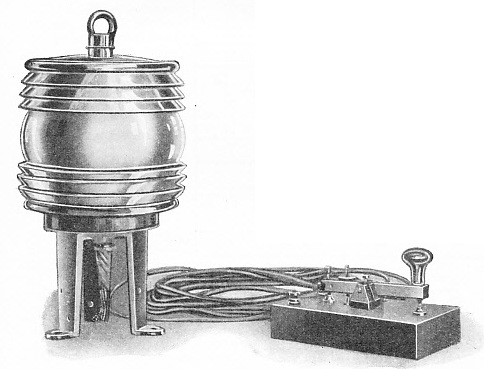
THE KEY AND THE LAMP are an integral part of Morse signalling equipment. On the right is the key, on which messages are tapped out by hand. The depression of the key completes the electric circuit. The lamp is attached to a prominent part of the ship. Since January 1, 1933, British ships of over 150 tons register, engaged on overseas voyages, have been compelled to carry a signalling lamp, which is generally fixed at the masthead.
Continuous blowing of the siren or fog-
Certain signals also are exhibited by lightships and lighthouses to call the attention of coastguards and lifeboat crews to vessels observed in distress. These generally consist of guns fired at regular intervals and of rockets.
A rocket throwing a white star indicates that the life-
When boats are observed trying to reach the shore (as from a wreck), the following signals are made to facilitate the dangerous task of getting boats safely beached in a heavy sea:
A flag or white light held steady -
Flag or flare waved from side to side -
Flag or flare waved and pointed to left or right -
Two flags or flares held about fifty yards apart -
All over the world ports have their own code of sign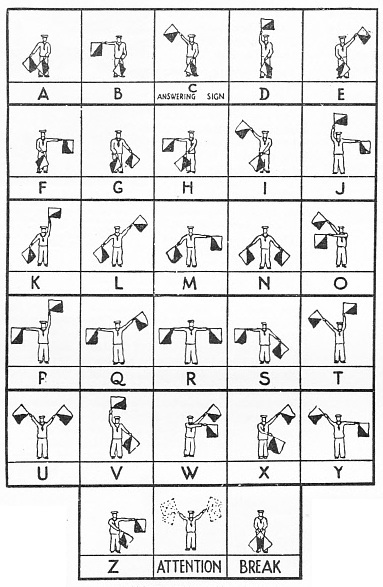 als made by balls, flags, semaphore arms and lights to control the entry and departure of vessels. The depth of water to be expected in the entrance to the harbour, or the conditions prevailing on a bar are shown for the information of ships approaching from seaward.
als made by balls, flags, semaphore arms and lights to control the entry and departure of vessels. The depth of water to be expected in the entrance to the harbour, or the conditions prevailing on a bar are shown for the information of ships approaching from seaward.
These regulations at Lowestoft (Suffolk) are typical of this class:
A black ball or green light -
A red flag or red light -
A red light on the swing bridge inside the harbour -
A green light -
A white light -
SEMAPHORE SIGNALLING with hand flags -
Navies have flag-
You can read more on “Buoys and Beacons”, “Day and Night Signals at Sea”,
“Distant Signalling at Sea” and “House Flags and Funnels” on this website.